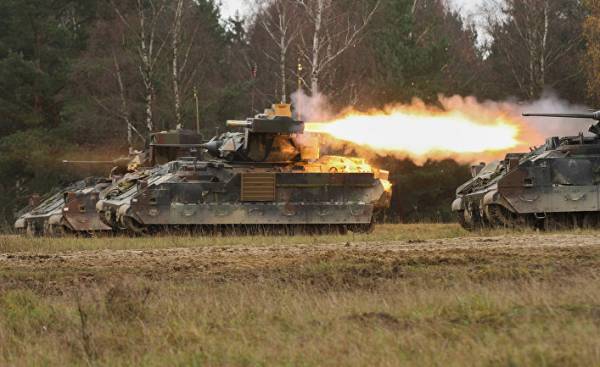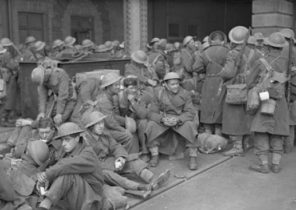
In the 1960-ies the Soviet army made a fateful choice, deciding that a tactical nuclear weapon — not a sentence. After the bombing of Hiroshima and Nagasaki, the military on both sides of the “iron curtain” had first considered now the main tool of war should be a nuclear bomb. However, over time they came to the conclusion that from now on the battlefield will dominate mobile army that is protected from radiation. The result is exactly that — in a roundabout way — led to the advent of the M2 Bradley, the first American infantry fighting vehicle.
In the 1950s the Soviet Union had invested a lot of effort and money in the creation of numerous and highly mechanized forces. However, the destructive power of nuclear weapons threatened to cancel large army as such — and along with large naval and air fleets. However, the Soviet Union, the largest land power of the 20th century, did not want to renounce to the advantages of numerical superiority and began to look for ways to keep it in the conditions of nuclear war.
If Soviet tanks had natural protection from the thermal radiation and shock wave, the infantry in armored personnel carriers with an open top was vulnerable. In the end, especially for her was created infantry fighting vehicle (IFV), which could fit a whole infantry squad and which was equipped with a 73-mm cannon and anti-tank missile Malyutka. Inside the BMP infantry could shoot at the enemy from his AK-47 through the side of the loopholes, but did it rarely. Instead of Dismounting during the attack, red army soldiers had to fight, staying in the military machine. This allowed them to move quickly across the field of battle is too fast to be able to cover tactical nuclear weapons.
Western military analysts belatedly came to similar conclusions. The US army continued to use the M113 armored personnel carrier. He was lightly armored and easily armed, and his only task was to take soldiers to the battlefield. Then they dismounted and went forward on foot. At the same time, as noted by the Soviet military, the slow pace of progress attacking dismounted soldiers made them an easy target for tactical nuclear weapons.
So, the army of the United States decided that they needed their own infantry fighting vehicle. The first attempt was the MICV-65, created on the chassis of the M109 self-propelled howitzers. It was fitted with a turret and a 20mm cannon. In the end the military rejected it, as it was too heavy to transport by air and too slow to keep up with the German-American main battle tank MBT-70.
It was one of the first dilemmas associated with the BMP. Infantry fighting vehicles were supposed to be big so they could fit a full infantry squad and a well-armored, because in the end, they had to be up to 12 people, three times more than in the tank. However, what they were larger and heavier than their armor, the slower and sluggish they become.
At the same time the Land forces required a new armored fighting reconnaissance vehicle reconnaissance platoons and regiments. To save money, the two projects decided to merge into one with two variants — the infantry fighting vehicle and reconnaissance vehicle. And there appeared another dilemma: BMP inhabited tower was above the tank and stood out on the battlefield and reconnaissance car, on the contrary, it was better to be low so that, if necessary, you can secretly observe the battlefield.
Prototype of the new machine, known as the XM723 was developed in 1973 FMC Corporation. The machine weighed 21 tons, and her crew consisted of three people and it could carry nine men. Her armor was able to withstand hits from 14.5 mm Soviet KPV heavy machine gun. As the Soviet BMP, it was small, designed for one-man turret with 20-mm cannon. The soldiers in the troop compartment located in the aft, too, could, as the red army Soviet infantry fighting vehicles, fire — but not from his arms and М231 adapted for firing through the loopholes modifications of the M16 rifle.
In the future, dilemma and compromise — kept on piling up on each other. 20-mm gun was replaced by 25 mm to the reconnaissance car was easier to deal with armored enemies easily. Compared to M113, XM723 much more likely to encounter enemy tanks, and therefore a new large double tower provided a container-launcher with two ready to fight anti-tank missiles TOW. It made sense to do more on a reconnaissance machine than a BMP, but the military decided that both models should use the same towers, equipped with anti-tank missile systems.
A big tower and heavier armament made the car bigger and heavier. M242 Bushmaster cannon and antitank missile system required additional space for ammunition. As a result, the space for three Marines were replaced with places for bullets, shells and missiles.
It was quite reasonable for the reconnaissance version, which required only two spatialdata scouts and ammunition. However, in combat the infantry version of this design change reduced the number of infantrymen in the troop compartment from nine to six. Although the BMP was now better able to deal with the tanks, as a result of the changes affected her ability to disembark infantry — that is, to what was its main task. The rifle firing through the loopholes on the case has never been used.
In the end, the XM723 was accepted for production. The result is called the fighting vehicle “Bradley” and began to produce in two versions: infantry fighting vehicle M2 and combat reconnaissance vehicle M3. Despite the fact that the basis of M2 and M3 was the different set of requirements, outside the two machines look the same. Although in General the project was successful in 36 years, not one of forced compromise solution was not fatal for him,- it’s hard not to wonder about what would happen if the military decided to do two different machines.
Fortunately for both sides, neither the Soviet army nor the us army have not tested infantry fighting vehicles in a nuclear war. However, the fact that the technique established in Moscow in 1955, indirectly influenced the technique used in Iraq in 2009, by itself, tells us much about the changing nature of military tasks. We don’t know what kind of cars will replace the M2 Bradley, and especially not know where they have to fight. However, one can say with certainty: a new battle machine, whatever it was, most likely, will do without a gun to fire through the loopholes.
Kyle mizokami lives in San Francisco and writes about defense issues and national security. His articles have been published in the Diplomat, Foreign Policy, War is Boring and the Daily Beast. In 2009 he founded devoted to the problems of defense and security blog Japan Security Watch.







